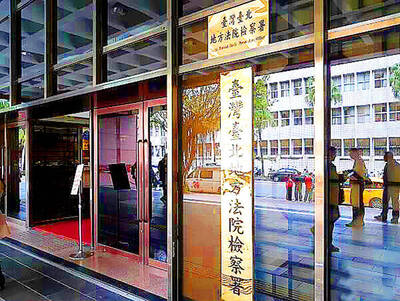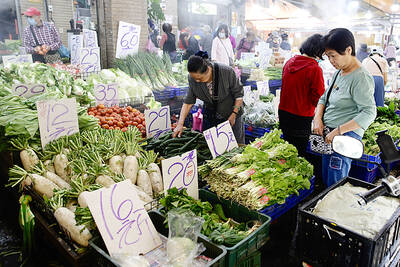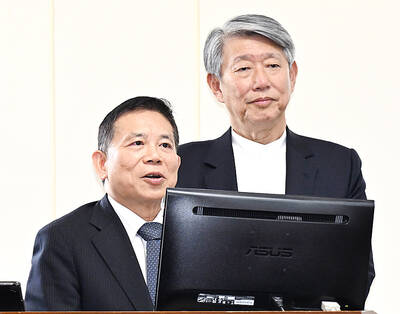Officials yesterday were at a loss to explain a mix-up by Premier Wu Den-yih (吳敦義), who told the legislature on Tuesday that the nation’s three operational nuclear plants were “much safer” than those in Japan because they were “fourth generation” — something both Taiwan Power Co (Taipower) and the Atomic Energy Council (AEC) have said is wrong.
“The Fukushima Dai-ichi [-nuclear power] plant was equipped with a third-generation [reactor], while Taiwan’s nuclear power plants operate fourth--generation ones,” Wu told the legislature, claiming that this alone made Taiwan’s plants safer.
SIMILAR PLANTS
However, as the Taipei Times reported yesterday, fourth--generation reactors are not expected to be commercially viable for another two decades and an investigation has shown that the types of -reactors used at the Japanese plant are very similar to those in Taiwan.
Asked for comment on the discrepancy, a senior Government Information Office official who was not authorized to speak to the media said: “Wu could have made a mistake,” referring further inquiries to the AEC.
For its part, the council said Wu was either misinformed or that information was “lost in translation.”
“Perhaps it is just a misunderstanding. Perhaps the premier was referring to the boiling water reactor types and mistook them for the generation variants,” said Chang Shin (張欣), an official at the council’s Department of Nuclear Regulation.
However, another council official speaking on condition of anonymity was more forthcoming.
The units at the Fukushima Dai-ichi plant, which started running in 1971, use three types of boiling water reactors (BWR). All six reactors are second--generation variants, the officials told the Taipei Times, information that was corroborated by the Japan Atomic Energy Agency.
Similarly, the first two plants in Taiwan — both in New Taipei City (新北市) — use BWR-4 and BWR-6 reactors and are the same second-generation variant as those used at Fukushima, the official said. Taipower also confirmed that no operational nuclear plant in Taiwan uses anything newer than second--generation reactors.
THIRD PLANT
For its part, the third plant, in Pingtung County, uses another second-generation device known as a pressurized water reactor (PWR), considered safer than BWR variants.
The most modern nuclear reactor in Taiwan is found at the Fourth Nuclear Power Plant, still under construction in New Taipei City’s Gongliao District (貢寮), which uses two advanced boiling water reactors. Those are third-generation reactors.
The three operational nuclear plants in Taiwan are therefore no more advanced than the Fukushima Dai-ichi power plant, the council official said.
In fact, all but one of the reactors at the Fukushima plant are either of similar design or more advanced — in the case of reactor six, which is a BWR-5 — than those at Taiwan’s first nuclear plant, the Jinshan Nuclear Power Plant.

Intelligence agents have recorded 510,000 instances of “controversial information” being spread online by the Chinese Communist Party (CCP) so far this year, the National Security Bureau (NSB) said in a report yesterday, as it warned of artificial intelligence (AI) being employed to generate destabilizing misinformation. The bureau submitted a written report to the Legislative Yuan in preparation for National Security Bureau Director-General Tsai Ming-yen’s (蔡明彥) appearance before the Foreign Affairs and National Defense Committee today. The CCP has been using cognitive warfare to divide Taiwanese society by commenting on controversial issues such as Taiwan Semiconductor Manufacturing Co’s (TSMC, 台積電) investments in the

INVESTIGATION: The case is the latest instance of a DPP figure being implicated in an espionage network accused of allegedly leaking information to Chinese intelligence Democratic Progressive Party (DPP) member Ho Jen-chieh (何仁傑) was detained and held incommunicado yesterday on suspicion of spying for China during his tenure as assistant to then-minister of foreign affairs Joseph Wu (吳釗燮). The Taipei District Prosecutors’ Office said Ho was implicated during its investigation into alleged spying activities by former Presidential Office consultant Wu Shang-yu (吳尚雨). Prosecutors said there is reason to believe Ho breached the National Security Act (國家安全法) by leaking classified Ministry of Foreign Affairs information to Chinese intelligence. Following interrogation, prosecutors petitioned the Taipei District Court to detain Ho, citing concerns over potential collusion or tampering of evidence. The

‘COMPREHENSIVE PLAN’: Lin Chia-lung said that the government was ready to talk about a variety of issues, including investment in and purchases from the US The National Stabilization Fund (NSF) yesterday announced that it would step in to staunch stock market losses for the ninth time in the nation’s history. An NSF board meeting, originally scheduled for Monday next week, was moved to yesterday after stocks plummeted in the wake of US President Donald Trump’s announcement of 32 percent tariffs on Taiwan on Wednesday last week. Board members voted to support the stock market with the NT$500 billion (US$15.15 billion) fund, with injections of funds to begin as soon as today. The NSF in 2000 injected NT$120 billion to stabilize stocks, the most ever. The lowest amount it

NEGOTIATIONS: Taiwan has good relations with Washington and the outlook for the negotiations looks promising, Minister of Economic Affairs J.W. Kuo said Taiwan’s GDP growth this year is expected to decrease by 0.43 to 1.61 percentage points due to the effects of US tariffs, National Development Council (NDC) Minister Paul Liu (劉鏡清) said at a meeting of the legislature’s Economics Committee in Taipei yesterday, citing a preliminary estimate by a private research institution. Taiwan’s economy would be significantly affected by the 32 percent “reciprocal” tariffs slapped by the US, which took effect yesterday, Liu said, adding that GDP growth could fall below 3 percent and potentially even dip below 2 percent to 1.53 percent this year. The council has commissioned another institution